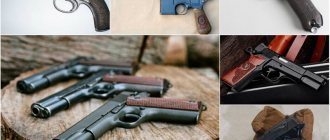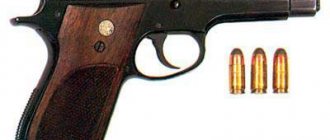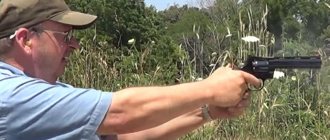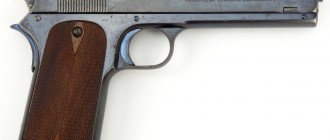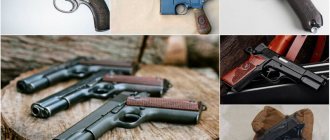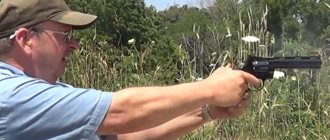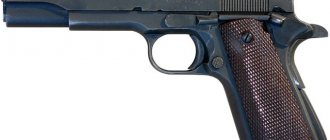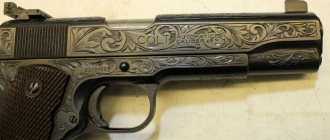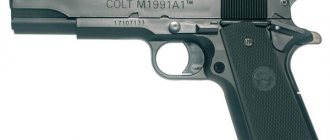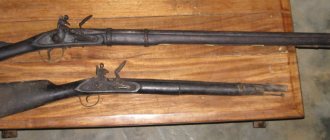A famous American proverb says that if God created people and Lincoln gave them freedom, then only Colonel Samuel Colt made them equal. We are talking about an American gunsmith, industrialist and inventor. Samuel Colt (1814-1862) made significant contributions to the development of firearms.
The capsule revolver he invented in 1835 quickly ousted other systems from the market. Colt even created a company to produce such pistols, but it did not immediately get back on its feet, going through bankruptcy.
After his unexpected death at the age of only 47, Colt left a rich inheritance, and his company with his name continued its triumphal march through the market. The 19th century for America was a time of charismatic people. The country got back on its feet and felt freedom and independence. One of the people with whom this era is associated was Samuel Colt. His name became a legend, and his image itself acquired many myths.
Samuel Colt invented the revolver
Although Colt's name is associated with the revolver, he did not invent it. The founder of the famous arms brand in 1835 created and received a patent for just a new revolver design. This happened in England and France. The American patent was received the following year. The design of the pistol itself with a rotating block of charging compartments was invented back in the 16th century. A flintlock revolver was patented in America in 1818. At its Patterson plant, Colt began producing five-shot single-action revolvers. The trigger had to be cocked with your thumb. But in 1842 the company went bankrupt. History has shown that the design of new percussion pistols turned out to be successful. They quickly replaced single-shot pistols. So the name Colt became associated with the revolution in gunsmithing, which led to the emergence of the myth. The inventor was lucky that America went to war with Mexico. The country's authorities ordered him a thousand revolvers at a price of $25. Already in 1847, Colt opened a new plant in Hartford and began producing up to 5 thousand pistols a year. After his death, this factory began to produce revolvers for firing unitary cartridges.
early years
American inventor Samuel Colt was born on July 19, 1814 in Hartford, Connecticut, one of eight children of textile manufacturer Christopher Colt and his wife Sarah Caldwell Colt.
Young Samuel was always interested in mechanics, and often took things apart to see how they worked. At the age of 16, he attended school but was eventually expelled from Amherst Academy in Massachusetts, where he studied navigation. In 1830, Colt sailed on Corvo as a sailor, where he first became fascinated by how a ship's wheel worked. From this idea, he carved a wooden prototype that led to his invention of the six-barrel rotary-type firearm.
Colt spotted his pistol design while sailing on a ship.
Legends say that in his youth Colt ran away from his father's house. He became a sailor and set off on a four-month voyage from Boston via London to Calcutta. A lover of pyrotechnics, Samuel began to observe the ratchet on the anchor capstan and the rotation of the steering wheel ratchet. This is how the original idea for a new revolver design came to his mind. In reality, everything was most likely much more prosaic. Colt was introduced to a pistol with a rotating breech in England. This flintlock model was created in 1813 by Boston gunsmith Elisha Collier. And the British sent 40 thousand of these pistols to England for their soldiers. It is symbolic that during the long voyage Colt personally carved a model of a revolver of his own design from wood. This was the first step towards the appearance of a legendary brand in the history of weapons.
Colt Walker (1847)
- The Colt Walker wasn't called the Behemoth for nothing. Just look at it: it's a really big gun.
Colt's second model. It is notable for the fact that it marked the beginning of the rise of revolvers as weapons: the government is interested in the development, Colt is generously sponsored and even gives him Ranger Captain Walker as a partner. The latter died during the Mexican-American War, so in his memory this revolver now bears his name. In addition, the Colt Walker is the favorite revolver of Clint Eastwood and his “nameless hero” from the Sergio Leone trilogy.
In the Wild West, the Colt was a popular weapon
This myth originates from numerous films about the Wild West. It was impossible to imagine brutal cowboys without a Colt. But historians say that problems in those years were usually solved not with a revolver, but with a shotgun. Accurate shooting required long training and a lot of ammunition. An ordinary cowboy had neither the time nor the means for this. So there were few sharp shooters with a pistol. Shepherds and cowboys driving cattle chose the shotgun as the only effective weapon. When fired from it there was a high probability of hitting the target - be it a person or a wild animal. And Colts were predominantly used by cavalry. The horseman on his side carried a saber and a pair of revolvers, which were convenient to shoot from at full gallop.
Colt Paterson (1836)
The Colt Paterson was the first model of the new revolver patented by Samuel Colt. The weapon was named after the city in which production took place. In fact, the Paterson was more of a prototype that went into production, and it is not surprising that it had quite a few disadvantages. At first, the new weapon was not appreciated, and Colt himself did not receive orders at all for about five years and became bankrupt.
Firearms were produced by Colt-Browning
Although Browning left a significant mark on the history of weapons, he was a modest man. The designer-inventor worked at Colt's company after his death. And Browning’s name never appeared on weapons produced by the company. It only appeared in patents. But the first Colt-Browning pistol appeared only in 1900 and was exotic. Five years later, the American army turned its attention to such weapons. It became especially popular, again, among cavalrymen. It was much more convenient for them to reload such a pistol than a revolver, and it fired faster. Border conflicts with the Mexicans were common in those years. And in the protracted war, the Colt M1911 pistol, invented by Browning, showed itself excellently. This weapon has become legendary for the manufacturer. The pistol is still on the market. Only he served in the American army until 1985, and today he is used by special forces. Thanks to the genius of the inventor, the pistol became extremely reliable and had a high potential for accuracy along with an effective cartridge.
January 10, 1862Colonel died
Samuel Colt
(Samuel Colt, 1814-1862), inventor of the 6-shot revolver. He is related to the history of anesthesiology due to the fact that at the beginning of his career he was a famous entrepreneur of a show demonstrating the inhalation of nitrous oxide. In the 30s of the 19th century, S. Colt, referred to on posters as “Professor Cult” or “Doctor Cult,” toured the United States with his show. In this way, he earned money to produce an experimental batch of Colt revolvers. It should be noted that in Great Britain and the USA in the first half of the 19th century, public demonstrations of nitrous oxide inhalation were no longer uncommon. As well as
ether frolics
(on-air pranks), these peculiar entertainments have spread quite widely not only in large, but even in small towns in the USA. The program of such "divertissements" by traveling lecturers and performers was usually a mixture of entertainment, magic tricks and popular science lectures on topics from electricity to chemistry, demonstrating various experiments to a venerable audience. After in 1799-1800. experiments carried out at Thomas Beddoe's Pneumatic Institute and Humphry Davy's repeated demonstrations of the stimulating effect of nitrous oxide at parties with friends became known, over the next few decades numerous lecturers began to include in their programs demonstrations of the effect of inhaling nitrous oxide on volunteers from public. This contributed to the spread of knowledge in society about the properties of nitrous oxide. And finally, what was supposed to happen happened. 27 year old dentist
Horace Wells
(Horace Wells, 1815-1848) from the American town of Hartford, having attended the performance of another popular demonstrator on December 10, 1844,
Gardner Quincy Colton
(Colton, Gardner Quincy, 1814-1898), comes to the conclusion that the analgesic effect of “laughing gas” can be successfully used during a very painful procedure - tooth extraction. The next day, December 11, 1844, Horace Wells practically proves the correctness of his idea, sacrificing his own healthy tooth. This event marked the first use of nitrous oxide for pain relief in dentistry. However, let's return to Colonel Samuel Colt. The Critical website invites its visitors to take a little break from everyday problems and concerns about the welfare of the Russian ISS service and read the story of Samuel Colt as “Christmas reading.”
COLT, SAMUEL (Colt, Samuel, 1814-1862).
North of New York, halfway to the East, is one of the smallest states in America - Connecticut. Here, on July 19, 1814, in the town of Hartford, the famous American engineer, American legend, Samuel
(Colt, Samuel, 1814-1862).
Horace
Wells (1815-1848),
was born and lived in the same town When Sam turned four, he was given a toy gun made of bronze. Wanting to transform the toy into a real weapon worthy of a man, the little experimenter stole a bunch of gunpowder from his father’s hunting horn, and soon an explosion occurred in the house. Sam, fortunately, was not injured, but this incident can be considered the beginning of his career as a weapons inventor. Little Sam often came to the factory to see his father, and was always interested in the structure and operating principle of the mechanisms and machines used in the factory. This played a very large role in his development as an engineer and inventor. When Samuel began working at his father's textile factory, he did not abandon his passion for weapons. Soon he managed to make a four-barreled pistol that fired four bullets simultaneously. His first creation was very heavy, and the recoil was so strong that it could cripple the shooter. When Sam was 15 years old, he became interested in studying the properties of voltaic batteries, which ended in another shock for the residents of a quiet town. On Independence Day in 1829, the child prodigy presented his fellow countrymen with a very unusual surprise. In the center of the city lake, he anchored a raft filled with gunpowder, connected it to the shore using an underwater electrical wire, and then, at the climax of the holiday, turned on the current. The raft flew into the air spectacularly. This, in essence, was the world's first underwater mine. Colt would subsequently develop and patent a true underwater mine with an electric fuse. Fearing that one day Sam would destroy the factory, his father sent him to study at the university. But the inventor continued his experiments in the temple of science. The result was a massive fire that broke out in a university building. I had to leave my studies... The future creator of the legendary revolver is hired as a sailor on a merchant ship. However, the young man does not abandon his fixed idea, which has taken possession of his mind since childhood - to create a lightweight multi-shot revolver, from which one could shoot several times in a row by simply pressing the trigger. After all, in those days there were only heavy revolvers, which had to be reloaded after each shot. While working as a sailor on the brig Corvo, young Samuel noticed that after turning the steering wheel, one of its handles fell into the gripping clutch and the steering wheel was fixed. Having used a similar mechanism in an attempt to create his own pistol, Colt developed the original revolver design. According to another legend, the idea of replacing the gun lock with a rotating drum came to Sam’s mind when he was watching the operation of a capstan
- a mechanism for selecting anchor or mooring ropes. However, the author of this revolutionary engineering solution was young Sam Colt. There, on board the ship, Colt built a wooden prototype of a drum for charges - the main part of all revolvers, suitable, however, for long-barreled weapons.
Inspired by the opening prospects, Colt ends his naval career. When, finally, in 1835, Samuel Colt managed to create a model of such a revolver, none of his friends and acquaintances believed that it could be fired. But the inventor was persistent. In 1835, Sam traveled to Europe and received English and French patents for his invention - a drum for revolver charges. February 25, 1836 22-year-old Samuel Colt receives a patent for his first revolver. With the help of his businessman uncle, he opens
and a weapons factory in Paterson (New Jersey). Sam also managed to attract John Pearson, the most famous gunsmith of those times, to cooperate. The first model of the revolver, without further ado, was named after the city in which the armory was located.
| 1836 Colt-Paterson revolver |
It was at this time that Colt traveled throughout the country, giving performances with “laughing gas” (nitrous oxide), since he constantly needed money to maintain production, produce prototype revolvers, etc. The multi-charge drum invented by Colt, which allowed rapid shooting, was clearly a revolutionary idea. And to some extent, it really made it possible to equalize the chances when attacking several against one - “to win in free competition,” which was very important for the Americans. This invention, in a certain sense, changed the course of history - if not world history, then certainly American history. By the beginning of the 19th century, all small arms were lock-type
(the fundamental design has not changed for several centuries) and single- or double-charged.
In fact, revolver prototypes have been known since the 16th century, but they did not make a difference, remaining more like firearms wonders than reliable, effective and, most importantly, mass-produced weapons. We should not forget our inventor Nartov, who lived back in the times of Peter the Great, who even surpassed overseas masters by trying to use a similar approach in artillery. However, as always happens, Colt’s innovation was not appreciated at first. Everyone, out of habit, preferred to use traditional castle muskets and pistols. The Colt revolver, as they say, “didn’t give a damn” to the Americans, despite the fact that the first buyers appreciated it. The government also purchased a small batch of weapons for the needs of the army. But Colt's product was sold in very small quantities, rarely exceeding 100 pieces. Eventually, the Paterson plant was closed and the Patent Arms Manufacturing Co.
was on the verge of bankruptcy.
In order to somehow delay its inglorious end, Colt traded in anything he could find: waterproof ammunition, underwater mines to protect bays, and even underwater telegraph cables (together with another Uncle Sam - Samuel Morse
, the inventor of the famous alphabet for telegraph operators).
During this flurry of activity, Colt, incidentally, developed an underwater mine with an electric fuse. And after much ordeal, luck finally turned to the inventor. As one might expect, this happened thanks to the military. Colt revolvers were well-received by the dragoons and Texas Rangers, who tested them in constant skirmishes with the Indians. Specialists from the West Point Military Academy were at first very skeptical about the new product, and yet, as an experiment, army commanders allowed it to be equipped with an expeditionary force that fought with the Indians in Florida and Texas. One of the corps officers, Captain Samuel
H. Walker, very highly appreciated the excellent fighting qualities of the new revolver. A significant reason for this was the successful outcome of the battle between his group of 16 people and 80 Indians. Subsequently, this legend became a fairly favorite subject for American battle painters, who painted a tough Walker brandishing a Colt Paterson in the thick of the battle with the Indians.
| Fight with the Indians. |
Such combat episodes and reviews from the rangers simply could not go unnoticed by military officials, and the demand for Colt revolvers began to grow rapidly. However, history, a capricious and vindictive lady, has brought to this day the legend of another dramatic battle, although it took place after the death of S. Colt. In June 1876, General George Custer and his 264 cavalrymen were killed in a battle with the Sioux Indians. By the way, American literature and cinema have sculpted the general into the image of a stern warrior-martyr who died in battle with treacherous savages. Meanwhile, the real Custer had shortly before ordered the complete extermination of an entire village of Cheyenne Indians. But they prefer not to remember this, and for most Americans, George Custer was and remains a national hero. Be that as it may, two months after his death, an editorial appeared in the Sunday Herald newspaper, which said that the tragedy might not have happened if the cavalrymen were armed with Smith & Wesson “third models”, and not Colt revolvers, which had to be cocked after each shot. Indeed, the first Colts had a significant drawback - the hammer of the revolver had to be cocked manually after each shot (remember how captivatingly beautiful and quickly the heroes of Westerns did this?). After this incident, the armory, which by this time had created a fundamentally new rapid-fire multi-shot pistol with a cylindrical magazine, took a leading position in the market for a long time. But that's a completely different story... In 1846, when the war with Mexico began, the government urgently ordered Colt a thousand new, modified revolvers. At the same time, Captain Walker, traveling in the Eastern United States, met with Colt and asked him to take him as an assistant. Their cooperation turned out to be very fruitful. Colt and Walker are creating a new model of the Colt Walker revolver for this government order,
which laid the foundation for the industrial production of this type of weapon.
| Model 1848 Colt Dragoon revolver |
To fulfill the order, a new plant was needed, and Colt asked Eli Whitney
(the son of the famous inventor of the cotton gin) to take over the factory he owned in Connecticut for production. After the new revolvers entered service with the army, the name Colt became known throughout America. Therefore, even after the end of hostilities, government orders did not dry up. The most popular model in America before the start of the Civil War was the Marine Colt Model 1851.
| Model 1851 Colt Navy Officer's Revolver. | Model 1851 Colt Navy Sheriff revolver. |
When Whitney's contract expired, Colt opened a gunsmith shop in Hartford. In 1852 he received a large government order for revolvers for naval officers. That same year, Colt bought “Southern Meadows,” a wasteland near Hartford, and in 1855 he built his own weapons factory, equipped with the latest science and technology. The focus was on mass production. During the Civil War alone, Colt supplied hundreds of thousands of small arms to government forces. In total, over a century and a half of existence, the company produced more than 30 million revolvers, pistols and shotguns (I wonder, has anyone calculated how many people were killed in total?) with the branded “Colt” engraving. From the very beginning of production, revolvers dominated the company's line, thanks to which the word "Colt" became one of the synonyms for revolver.
| Colt Arms Factory in Hartford. |
It is worth noting that mostly piece goods were produced in Paterson. The main buyers of Paterson's expensive toys, which amazed with their elegance and richness of decoration, were not hard-working cowboys from the Wild West, but rich people from the East Coast. For them, a Colt with gold and silver checkering and inlay was as iconic an item as a gold Rollex is for the modern nouveau riche. But the products from Hartford were designed for a simpler buyer. Already in the first year, the plant produced up to 150 “barrels” per day. Soon after the opening of the plant, its roof, on the personal instructions of the owner, was decorated with an onion dome, topped with a bronze figurine of a rearing foal (one of the meanings of the word colt). This architectural excess looked rather incongruous, especially considering that Hartford was a typical provincial New England town, but it quickly became the main local attraction for visitors and a source of pride for the townspeople. And at the same time, the figurine of a foal became the corporate symbol of the company. Colt's Patent Fire Arms Manufacturing Company in 1855
made Hartford famous, as the whole of America armed itself with its products.
And its head, who received the rank of colonel from the governor of Connecticut (not for his weapons merits, but simply for his support in elections, as happens now), soon became one of the ten most successful industrialists in America. Although the company was formally a corporation, its sole owner was Samuel Colt himself, who owned 9,996 of the 10,000 shares issued; the rest went to his closest assistants (one each). Colt's entrepreneurial activity was marked by several revolutionary innovations: he was one of the first in the United States to engage in what is today called marketing, including outdoor and print advertising, direct mailing of samples, and even the beginnings of today's PR. All manufactured products were sold to a small number of traveling salesmen (or agents), as well as 15-20 wholesalers (through them the goods were distributed to stores and gun shops). In addition, the Colt factory also accepted individual orders from wealthy clients, friends and relatives of the owner. It was possible to order a whole batch of weapons. In addition to mass products, with the help of which ordinary Americans ensured their personal safety, and the police and army, respectively, national and public safety, Colt continued to produce exclusive goods designed for true connoisseurs. These were real masterpieces, the fruits of the efforts of talented chasers, inlay makers and metal and wood carvers. Colt's precious weapons were presented at the most prestigious exhibitions and auctions, and were presented as gifts to royalty: Colts were kept in the collections of Nicholas I and Alexander II, the Danish king Frederick VII and the Swedish Charles XV. Without any exaggeration, Colt’s residence in Hartford, Armsmear
, recognized as one of the most beautiful buildings in New England, can also be called a work of art.
After the outbreak of the American Civil War, the health of the arms king began to deteriorate. Samuel Colt died on January 10, 1862, in Hartford, at the age of just 47, leaving behind an estate estimated at $15 million, approximately $300 million in today's money. The common phrase: “God created men free, but Colt made them equal” actually came to light only after his death. And in the original version, during the American Civil War, it was like this: “Lincoln freed the people, and Sam Colt equalized their rights.” For the famous gunsmith, these words would have sounded like heavenly music, had he lived to see the triumph of his invention. However, even during his lifetime, Colt achieved fame that his fellow inventors rarely achieved. When Samuel Colt died in 1862, the business was inherited by Colt's widow, Elizabeth Hart Jarvis, and her family. In 1901, the company came under the control of a group of investors. It is quite difficult to write about Samuel Colt and the products of his company, it is very difficult to stop in time, this person is so interesting and extraordinary. Samuel Colt is a legend and symbol of the United States. His name always arouses great interest among people. It is no coincidence that when asked about S. Colt on www.altavista.com, the search engine returned more than 18 thousand results. Among them there are links to “advanced, sophisticated” sites dedicated to the life and work of Colt, containing a lot of interesting information, and there are numerous links to one or two-page “hamsters” (home page). In any case, those interested in the biography of Samuel Colt have something to see. You can familiarize yourself with the website www.colt.com, especially since a detailed translation of the historical page of this site in the form of an article (under different authors) is available in the archives of the electronic publications Kommersant and Morning. Today, Colt remains one of the leading firearms manufacturers. The company's model line extends from miniature ladies' pistols to heavy army machine guns, shoulder-mounted anti-aircraft weapons and other serious lethal equipment. Among the hits of the brand are the world-famous 45-caliber pistol and the M16 army automatic rifle. However, as a farewell, we invite you to plunge into the atmosphere of the late 19th century and admire the prototypes of the first machine guns produced at that time by Colt.
| Colt engineer Dr. R. J. Gatling presents the Model 1873 Mechanical Gatling Gun. | 1897 Inventor John Browning, who collaborated with Colt, tested the BAR (Browning automatic rifles) machine gun. |
Colt invented the American production system
One should not attribute such an invention to the industrialist and gunsmith. He was an innovator and showed the whole world all the possibilities of this system. Its main postulates were standardization, narrow specialization, interchangeability and rigid hierarchy. And the discipline at Colt's production was almost military. At 7 a.m., the worker was required to be at his workplace when the steam engines were started. If an employee was late, he was no longer allowed into the workshop. Exceptional sobriety was required of personnel in the workplace. Before Colt, gun production was practically a hand job. And each sample was unique. Parts of one pistol might not fit another; they needed to be modified on site. Colt himself created the machines and set up mass production of all components, trying to ensure their maximum interchangeability. For the 19th century, the idea turned out to be simply a breakthrough. Another plus was that mass production and the use of machines led to cheaper weapons. Handmade work by an experienced craftsman was expensive. Thanks to this competitive advantage, Colt was able to conquer the market.
Colt pistols did not require advertising
The businessman turned out to be a talented marketer who understood that advertising drives trade. Colt did not shy away from self-promotion. He commissioned the artist George Catlin, known for his work on Native Americans and life in the Wild West. As a result, Colt revolvers appeared in ten of the master’s paintings. Six of the designs made it to the mass offset printing market. In one of the paintings, Catlin even depicted himself sitting on a horse and holding Colts in his hands, herding buffalo on the plain. Colt himself hired writers to write stories about his revolvers. The businessman traveled the world, presenting his richly gold-trimmed items to heads of state. After the Ottoman Sultan received the golden revolver, Colt received an order for 5,000 pistols. The businessman even built the company logo based on his own signature. In total, Colt gave away more than 2,500 of his pistols.
Colt "Peacemaker" / Colt Single Action Army (Peacemaker) (1873)
Perhaps the most popular of the first generation Colt revolvers. Together with the Winchester rifle, the Colt Peacemaker became a symbol of the Wild West and everything connected with it. At that time, a more widespread and popular weapon model simply did not exist. The main difference from the first Colt revolvers is that the Peacemaker uses unitary cartridges, that is, it is able to load much faster: there is no need to fuss with gunpowder and spherical bullets.
On the one hand, Samuel Colt created a weapon that was utilitarian and incredibly effective for those times and, according to the proverb, equalized the chances of people. On the other hand, these revolvers are real works of art that you can admire forever.
Colt dealt only with revolvers
As a teenager, Colt experimented not only with gunpowder, but also with electricity. In fact, bold experiments with pyrotechnics led to the young man’s expulsion from school. At this time he was working on the design of a detonator. Colt used wire rolled into a tarred rope and connected an underwater explosive device. But the spectators, whose elegant clothes were stained with mud and water, did not appreciate the engineering idea. And in the 1840s, Colt returned to his youthful experiments and partnered with telegraph inventor Samuel Morse to improve water-resistant cables. Colt, commissioned by the American government, came up with a sea mine with an electric fuse.
Colt was a talented inventor who came up with many classic weapon models
Although Colt’s ingenuity cannot be denied, he was not a prolific inventor. He received a patent for a drum pistol, but the first weapon, the Colt Paterson, was created in collaboration with Captain Samuel Walker. They say that it was he who made the main efforts towards the appearance of a new revolver. Colt can be considered more of a businessman and an innovator in the field of labor organization. He was considered an excellent showman, he skillfully used advertising. His factory employed women, which was a bold move. The working day lasted 10 hours with a lunch break. And the most famous classic Colt models were released after the death of the industrialist. And a significant part of the credit for this belongs to Browning, who developed the new weapon. Colt himself is credited with only one legendary model, the 1840 pocket revolver. By the time of Samuel's death, 325 thousand copies of such weapons had been sold.
Personal life
The famous inventor of firearms was married once - to the daughter of a priest, the girl's name was Elizabeth. The young people met in 1851 and got married a few years later. The couple had four children, who, unfortunately, died - some earlier, some later. After Samuel's death, his production company was inherited by his wife Elizabeth. The woman had enough wisdom, strength and inspiration to continue her husband’s business, and therefore Colt’s Manufacturing Company still operates and continues to produce firearms to this day.
Colt's bankruptcy was due to its unsuccessful product
With a patent in hand, Colt turned to his wealthy relatives in New Jersey for help and opened a production facility in the town of Paterson. However, in 1842 the company declared bankruptcy. Over six years of work, 5,000 pistols and rifles were produced. The reason for the failures does not lie in the quality of the product. Colt simply chose the wrong time and place. He looked at little New Jersey as if it were endless Texas. And in 1837, the market collapsed after bank riots and panics. The country was going through hard times. And America didn’t fight with anyone in those years; it simply didn’t need new weapons.
Development of advanced weapons
In 1845, the US government heard from its front: The militia line indicated that Colt firearms, weapons that did not require constant reloading, were instrumental in defeating the Indians in Texas and Florida. The following year, at the start of the Mexican War, he and Army Captain Samuel H. Walker developed an even more effective weapon, the Walker, prompting the government to order 1,000 of them, and Colt was back in business again.
His company, Colt's Patent Fire Arms Mfg. Co. was founded in 1855 in Hartford, with offices in New York and London. The company was soon producing 150 firearms a day, making Colt one of the richest men in America.
Colt pistols were the weapon of choice during the American Civil War, from 1861 to '65, and the company's .45-caliber Peacemaker, introduced in 1873, became the most popular weapon in the West. Another revolver model was used during the First and Second World Wars.
